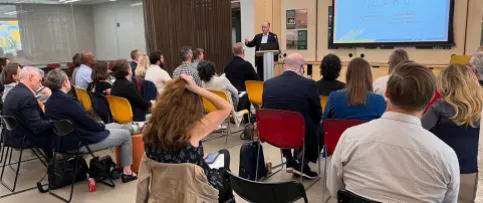The opinions expressed in this commentary are solely those of the author and do not necessarily reflect those of the National Council of Architectural Registration Boards (NCARB).
One thing to come out of the 2016 presidential campaign is the attention the man vs. woman contest has brought to the persistent, pernicious, and seemingly pervasive issues of gender bias in American society. Surprisingly, women in the building industry have never had more opportunities than they have right now. The number of women selecting professional architecture programs continues to grow, with women representing 46 percent of new students, according to the National Architectural Accrediting Board (NAAB). Women can get into the career, but they don’t reach the top. The opportunities for female career advancement remain resistant to change.
According to NCARB, on average, women earn an initial license one year sooner than their male peers. Women complete the Architectural Experience Program® (AXP®) in consistently shorter time. So what’s the fuss about? Why are we still having conversations about equity?
Why Women Leave Architecture
In 2015, 42 percent of new NCARB Record holders were women, compared to 34 percent of new architects. Now there’s the rub: after a jackrabbit start, the barriers to advancement start mounting. We cannot ignore the fact that women are paid less from day one, and the pay discrepancy is greatest, according to the 2014 AIA San Francisco Equity in Architecture Survey, among those with the most experience. So somewhere along the road, women just get off the path, even though both men and women equally cite lack of opportunity as a reason to leave their jobs.
Women are about seven times more likely to reduce their workload to care for children, according to the Equity in Architecture Survey. They are more likely to work in smaller local firms, and women report in significant numbers that they leave large offices (more than 75 employees) to achieve work/life balance, while men overwhelmingly report that they move on to achieve design autonomy.
When women get back on the career path following a leave, they find that their advancement trajectory has been set even farther back. A seeming lack of commitment to their career (as defined by whom?) further erodes compensation opportunities. Without the support of female senior leadership, both as exemplars of success and mentors, women are frustrated by less desirable projects and limited project roles. Until the proportion of women in senior leadership positions is doubled, the delicate balance of professional satisfaction, even still undermined by discriminatory compensation, cannot be balanced. “It’s not worth it,” they say. A choice is made. The statistics don’t lie.
Changing the Statistics
We change this first by requiring equal pay for equal work. Next on the list is being sure to provide talented women at mid-career the opportunities for advancement that they deserve. More women will stay in the profession, and with more women in leadership positions, there will be more opportunities to mentor future generations of female architects.
I joined the Beverly Willis Architecture Foundation (BWAF) because I've lived the challenges first hand, both as an architect and through my AIA work with colleagues in the field. BWAF is a national research and educational nonprofit working to change the culture of the building industry so that women’s work—past, present, and future—is acknowledged, respected, and valued.
We achieve our mission by documenting women’s work, through projects like the Dynamic National Archive, an online database of women in the built environment. Built by Women exhibitions have taken place in New York and Washington, DC, and we are interested in expanding to other cities. Short films like A Girl is a Fellow Here, about 100 women who worked in Frank Lloyd Wright’s studio, shine light on women in architecture. Through all of these programs, we are able to expand knowledge about women’s contributions to 20th century American architecture by uncovering their lost histories and restoring them to record—as envisioned by our founder and a pioneering architect, Beverly Willis, FAIA.
By recognizing the talents and achievements of women in architecture, both past and present, we can help redefine the building industry. We can support the advancement of women in this profession, and help ensure their voices are heard.



